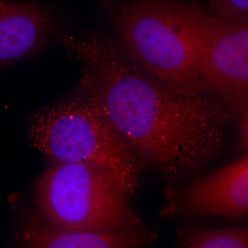Scientists from the Weizmann Institute resolved the mystery of how RNA molecules get to their intended destinations.
Each cell in our body receives instructions from its DNA, on how to function, in the form of RNA molecules. RNA has lately gained attention as the foundation for cutting-edge COVID-19 vaccines, but fundamental information about this important molecule, such as how it travels inside cells to a specific area, is still lacking.
Now, the Weizmann Institute of Science researchers have identified a cellular “postal code” system that ensures that all RNA is delivered to the appropriate location at the appropriate time.
After the RNAs are made in the nucleus, some remain to control gene expression, but the majority—especially those RNAs that include protein-making instructions—are intended to depart the nucleus for the cytoplasm, where proteins are produced.
Previous investigations to determine how RNAs reach their designated sites have yielded contradictory results. Some hypothesized that information at the loose ends of the linear, string-like RNA molecules might direct the molecules’ paths. Some RNAs, however, are circular and, evidently, lack ends.
However, there was no understanding of how such zip codes would function in different research reports on different zip codes. Other studies discovered evidence that specific short portions within RNA molecules may act as zip codes, identifying the neighborhood in the cell where each RNA belongs.
Scientists Maya Ron and Igor Ulitsky, both from the Immunology, Regenerative Biology, and Molecular Neuroscience Departments at the Weizmann Institute of Science, used a method called a “massively parallel RNA assay,” which was partly created in Ulitstky’s lab, to investigate the zip code concept.
The method allows for the simultaneous analysis of thousands of distinct RNAs, yielding results in days as opposed to the years it would have previously taken to research these same RNAs one by one. The researchers created copies of various “host” RNA molecules, either circular or linear, by inserting thousands of unique RNA segments into them. These copies were then given to millions of cells. The scientists were able to determine the location of these cells’ RNAs after separating these cells’ cytoplasm from their nuclei.
Through this analysis of 8,000 DNA segments, Ron and Ulitsky found that 12 of them do, in fact, serve as zip codes. These zip codes tell certain RNAs to stay in the nucleus, others to move immediately away into the cytoplasm, and still, other RNAs to move into the cytoplasm after some time in the nucleus. The researchers also discovered a variety of proteins that serve as “postal clerks.” These proteins bind to the RNAs, “read” the zip codes they contain, and then transport the RNAs to the locations indicated.
Currently, many companies are producing RNAs for use as medicines or vaccines. Understanding how they enter the cell could aid in creating artificial RNAs with the necessary qualities.

Image Source: Nature Communications, doi:10.1038/s41467-022-30183-0
Surprisingly, within this “postal system,” there was a precise distinction between linear and circular RNAs. To begin with, depending on whether an RNA is linear or circular, the same zip code may allocate it to a different place. Additionally, two teams of postal clerks—one for linear RNAs and another for circular RNAs—performed the sorting. In reality, each clerk gave their own distinct set of instructions. For instance, one protein, IGF2BP1, is mostly bound to linear RNAs, encouraging their export from the nucleus. Another one, known as SRSF1, is adept at guiding circular RNAs to remain inside the nucleus. The RNAs sorted by each of these postal clerks failed to arrive at the appropriate spots in the cell when the scientists obstructed the function of specific proteins.
These discoveries may help with the development of RNA-based medicines, in addition to providing new insight into how the genome functions. According to Ulitsky, several businesses are currently creating RNAs to be utilized as medications or vaccinations. It may be possible to produce artificial RNAs with desired qualities by understanding how they enter cells. For instance, an RNA medication can be created to spend most of its time in the cytoplasm, where the desired protein can be made in high quantities.
According to Ron, findings from the study may be especially helpful for circular RNAs, which have only recently risen to the forefront of research and are less well understood than linear RNAs. Only a small portion of RNAs in nature are circular, but because they are more stable than linear ones, they are being used more and more in drug development.
Story Sources: Ron, M., Ulitsky, I. Context-specific effects of sequence elements on subcellular localization of linear and circular RNAs. Nat Commun 13, 2481 (2022). https://doi.org/10.1038/s41467-022-30183-0 https://wis-wander.weizmann.ac.il/life-sciences/%E2%80%9Czip-codes%E2%80%9D-tell-rna-where-go
Learn More About Bioinformatics:
Top Bioinformatics Books ↗
Learn more to get deeper insights into the field of bioinformatics.
Top Free Online Bioinformatics Courses ↗
Freely available courses to learn each and every aspect of bioinformatics.
Latest Bioinformatics Breakthroughs ↗
Stay updated with the latest discoveries in the field of bioinformatics.
Dr. Tamanna Anwar is a Scientist and Co-founder of the Centre of Bioinformatics Research and Technology (CBIRT). She is a passionate bioinformatics scientist and a visionary entrepreneur. Dr. Tamanna has worked as a Young Scientist at Jawaharlal Nehru University, New Delhi. She has also worked as a Postdoctoral Fellow at the University of Saskatchewan, Canada. She has several scientific research publications in high-impact research journals. Her latest endeavor is the development of a platform that acts as a one-stop solution for all bioinformatics related information as well as developing a bioinformatics news portal to report cutting-edge bioinformatics breakthroughs.






